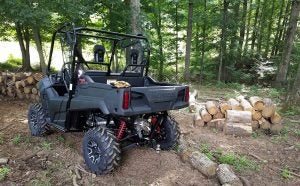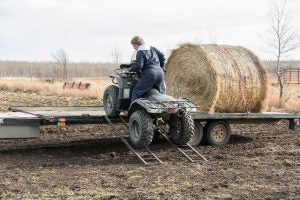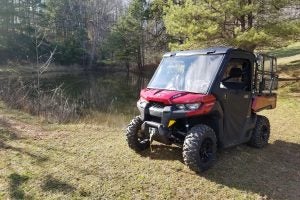Which four-wheeler best suits your needs? We take a look at how and why ATVs and UTVs can be useful tools for farmers and landowners.
An ATV, or all terrain vehicle as defined by the American National Standards Institute (ANSI), is a quad, quad bike, three-wheeler, four-wheeler, or six-wheeler that travels on low-pressure tires. Fair enough, but from that humble three-wheeler roots has grown a cottage industry dominated by well-known manufacturers such as Honda, Kawasaki, Artic Cat, Yamaha, Can-Am, Suzuki, Polaris, and John Deere.

A UTV, or utility task vehicle, is an outgrowth that no longer gets an ANSI definition. Sometimes referred to as a side-by-side, UTVs are two- or four-person motorized off-road vehicles usually with wider and longer stances than ATVs. The explosion in this industry has led to hybrids with classifications such as XUV, or crossover utility vehicle, and ROV, or recreational off-highway vehicle.
But which type of four wheeler makes the most sense is a question that requires more thought than just one has a steering wheel and the other handlebars — which do you prefer?
ATV
Let’s start with some of the technicalities and capabilities of these machines. ATVs are offered in 2WD and 4WD versions but in the spirit of all-around performance, we’ll concentrate on 4WD ATVs. ATVs can be had in a variety of configurations. V-Twin engines to 700+ cc displacements, electronic fuel injection (EFI), electronic power steering (EPS), front and rear hydraulic disc brakes, and automatic transmissions with engine braking capabilities are all possibilities. Of course, with each of those niceties comes additional cost. Cargo carrying is generally limited to 100 pounds in the front and 200 pounds in the rear using cargo racks, towing capacity can be surprising. As well, most ATVs are meant for just one person, though two-person units are available, particularly on six-wheelers.
![]()
With industry base price ranging from just under $4,000 to more than $16,000, let’s focus on a mid-price machine such as the 2019 Honda FourTrax Foreman Rubicon. With a MSRP starting at $8,599, the Rubicon features a 475cc liquid-cooled OHV longitudinally mounted single-cylinder four-stroke engine with PGM-FI induction and a full-transistorized ignition. Overall length is 84.5 inches and the width is 47.4 inches. Ground clearance is 9.4 inches, and the suspension is independent in front and swing arm at the rear. Front and rear brakes are hydraulic discs. The Rubicon weighs 705 pounds and can tow up to 1,322 pounds using a drawbar arrangement. Turning radius is 10.5 feet.
PROS: Lighter weight equals less turf impact, lower cost, good towing capacity, requires less real estate for storage
CONS: No passenger room (usually), minimal cargo carrying capacity, straddle seating position, no rollover safety enclosure
UTV
UTVs are generally larger than ATVs, and with that extra space, designers and engineers seem eager to fill them with larger engines and more deluxe features. That doesn’t necessarily translate into more capability, as the weight also goes up. So, horsepower per pound ratios can be pretty close.

With base sticker prices ranging from $8,000 to well over $18,000, we’ll look at the Honda Pioneer 700 which has a MSRP of $10,799. For that, the user gets a 675cc liquid-cooled OHV single-cylinder four-stroke engine, PGM-FI induction, full-transistorized type ignition with electronic advance, independent double-wishbone front and rear suspensions, and hydraulic disc brakes front and rear. The Pioneer 700 measures 114.7 inches long and 59.7 inches wide. Ground clearance is 10.7 inches, and the turning radius is 14.8 feet. The bed, which tilts to dump, can carry up to 1,000 pounds, and the UTV can tow up to 1,500 pounds. The 700 weighs in at 1,268 pounds, but it can carry a driver and passenger.
PROS: Passenger seating, dump bed with generous capacity, rollover safety enclosure with seat belts and side webbing, automotive-style seats with better legroom, receiver hitch for towing, ability to add sunshade and cab options
CONS: Higher cost, larger footprint and turning radius
Which Four-Wheeler Is Right For You?
In our opinion, it all comes down to your budget, the available space you have for operating and storage, the need for passenger space or not, towing and cargo capacity, and what implements/attachments/accessories will help get your chores done.

If you find the decision daunting, don’t rush into your purchase — do your homework. ATV.com and manufacturers’ websites are good places to start, but get to know your dealer. He/she will be the one who will listen to your requirements and expected usage and make recommendations based on those needs. We’re also big proponents of taking a look at the dealership for telltale signs: Is it neat and organized? Is the salesperson willing to introduce you to the service manager and/or owner? Does the salesperson make it a point to show you the service area? All of those points are opportunities to assess the dealership. Ask yourself: Is this the dealership you would want going to bat for you on a warranty or even an out-of-warranty claim?
When you’re comfortable with the selection of a dealer and begin to narrow down your choices, we recommend you test drive each. While doing so, pay attention to ergonomics, comfort, and balance. You are going to shell out a healthy amount of hard earned coinage, so this should be a machine you will enjoy spending time in or on.
Don’t forget that ATVs and UTVs can be quite a bit of fun when the work is done. Other important areas to pay attention to would be the ease of maintenance built in, the quality of fit, and the components used.

A version of this article was originally published here on our partner website Tractor.com. It has been updated and adapted for AGDAILY.


